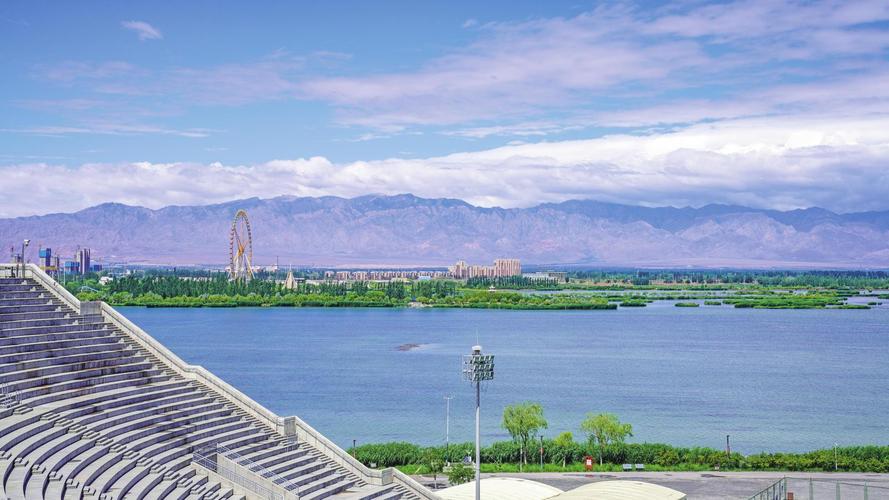Nestled between the majestic Helan Mountains and the mighty Yellow River, Yinchuan—the capital of China’s Ningxia Hui Autonomous Region—is a city of striking contrasts. Known as the “Phoenix City” for its mythical origins and the “Jiangnan of the Saibei” for its lush oasis-like landscapes, Yinchuan seamlessly blends ancient history with modern innovation, offering travelers a unique cultural tapestry.
Urban Development: A Harmonious Blend of Tradition and Modernity
Yinchuan has evolved into a thriving regional hub under China’s “Big Yinchuan” development strategy. As a key node on the Belt and Road Initiative, the city boasts advanced infrastructure, including the Yinchuan Hedong International Airport and a comprehensive high-speed rail network connecting it to major cities like Xi’an and Lanzhou. Recent efforts in eco-friendly urbanization are evident in its sponge city projects, which optimize water management in this arid region through permeable pavements and wetland restoration. Meanwhile, the rapid expansion of EV charging stations reflects its commitment to sustainable growth.
The city’s layout mirrors its cultural identity: the historic Xingqing District preserves ancient pagodas and mosques, while the Jinfeng District showcases sleek skyscrapers and tech parks. For a taste of local life, stroll through Ziqiang Alley, a revitalized lane adorned with murals of phoenixes and QR codes linking to augmented-reality historical tours.
A Journey Through Millennia: Yinchuan’s Historical Legacy
Yinchuan’s history spans over 30,000 years, beginning with the Shuidonggou Paleolithic Site—one of China’s earliest human settlements. It rose to prominence as the capital of the mysterious Western Xia Dynasty (1038–1227), whose legacy lives on in the Western Xia Mausoleums, a UNESCO-listed complex of pyramid-like tombs dubbed the “Oriental Pyramids”.
The Helan Mountain Rock Carvings, with over 6,000 ancient petroglyphs, offer a glimpse into nomadic life dating back to the Spring and Autumn Period. For a cinematic twist, visit Zhenbeibu Western Film Studio, where movies like Red Sorghum and A Chinese Odyssey were filmed amid reconstructed Ming-Qing fortresses.
Must-Visit Attractions: From Desert Adventures to Lakeside Serenity
- Sand Lake (Shahu): A surreal blend of desert dunes and wetlands, home to migratory birds like red-crowned cranes. Try sandboarding or a tranquil boat ride.
- Lanshan Park: Climb the Roman-inspired amphitheater at sunset for panoramic views of the Helan Mountains—a viral Instagram spot.
- Ningxia Museum: Dive into the region’s multicultural heritage, from Silk Road artifacts to Hui Islamic art.
- Yellow River Ancient Ferry: Experience traditional sheepskin raft rides and camel treks at this historic river crossing.
A Feast for the Senses: Yinchuan’s Culinary Wonders
Yinchuan’s cuisine is a fusion of Hui Muslim flavors and northwestern boldness:
- Hand-Ripped Lamb (Shouzhua Yangrou): Tender, steamed lamb served with garlic-infused vinegar. Try it at Laomao Shouzhua, a century-old restaurant.
- Lamb Paomo: Crumbled flatbread soaked in rich lamb broth, a staple at breakfast stalls.
- Spicy Hu Hu: A fiery street-food delight of skewered vegetables dipped in chili-paste broth.
- Helan Mountain Wine: Sip award-winning Cabernet Sauvignon at vineyards like Château Zhihui Yuanshi, where desert terroir meets French winemaking.
For an immersive food crawl, head to Huaiyuan Night Market, where vendors dish out crispy beef pies, rose-flavored yogurt, and honey-glazed lamb skewers.
Final Thoughts
Yinchuan is more than a gateway to the Silk Road—it’s a living museum where ancient petroglyphs coexist with AR-enhanced alleys, and where the silence of desert dunes contrasts with the sizzle of night markets. Whether you’re tracing the footsteps of vanished empires, savoring a lamb feast, or toasting with local wine under starry skies, Yinchuan promises a journey that resonates long after you leave.
Pack your curiosity—and an empty stomach—and let Yinchuan’s magic unfold. 🌄✨
: Overview of Yinchuan’s geography and history.
: Cultural revitalization in historic alleys.
: Urban development strategies.
: Sustainable city initiatives.
: Historical sites and archaeological significance.
: Origin of the “Phoenix City” legend.
: Desert-oasis contrasts and tourism highlights.
: Key attractions and film studio.
: Museums and parks.
: Visitor reviews and activity recommendations.
: Culinary heritage and wine culture.
: Traditional dishes and iconic restaurants.
: Street food and local flavors.
